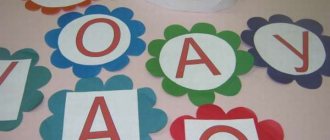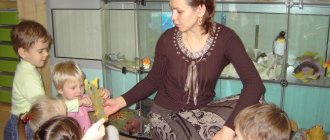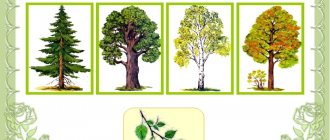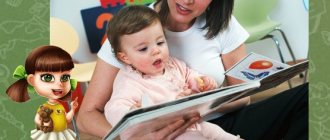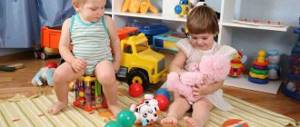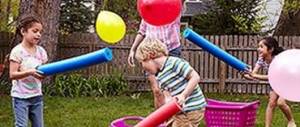Learning as fun: fire safety quest in kindergarten
Children are able to learn more and more deeply if learning occurs in the form of entertainment.
Role-playing games: “Ogonyok is always like this - both good and bad”
In this quest, the teacher begins the lesson with a rhyme: “The light is always like this - both good and bad, It shines, it warms and knows how to play pranks.”
Next they talk about the benefits it brings and the dangers that may threaten.
Then repeat the safety rules when handling fire. They ask who comes to help if there is a fire (firemen, doctors).
Next, the children are asked what needs to be built? (Fire department).
After this, a fire department is created from soft modules, the kids dress up as participants in the action (firemen, builders, housewives, doctors). Then thematic scenes are played out.
Development of a four-year-old boy or girl, what a child should know
Note! In conclusion, they repeat the basic rules that need to be learned.
Motivating moments during the game
The main interest in role-playing games is participation in ongoing events. Children feel themselves in the shoes of the characters and better understand the peculiarities of the situations taking place.
Physical school
In childhood, the opportunity to move and play in the process is of great importance for the assimilation of material and the excitement of the lesson.
The following explains how to conduct a physical exercise. When conducting it, the teacher, together with the boys and girls, pronounces poetic phrases, and they perform certain movements:
- They say “We are friendly guys and we are going to a fairy tale,” the children, moving in a circle, stride, raising their legs high.
- When they say: “Let's see who in the fairy tale will put out the cat's house,” the kids bend forward and backward while moving.
- “And if necessary, we will also help.” At the same time, the children continue to move in a circle, being in a half-squat. They keep their hands on their knees.
- When it is said: “And we will tell everyone: “You can’t play with fire,”” the kids make turns to the right and left as they move, shaking their fingers.
Game script, skits and tasks on fire safety in kindergarten
In order for children to better grasp important knowledge, it is necessary to carefully prepare and plan a fire safety scenario in kindergarten.
Firefighting activity
Goals of classes on fire safety within the framework of the pedagogical process in preschool educational institutions
Classes are held to provide children with basic fire-fighting knowledge and to foster interest in the profession of firefighter.
Specific tasks and techniques relevant for different age groups
When playing fire safety games for preschoolers, the following can be used:
- Conversations in which teachers pass on knowledge to children.
- Displaying thematic images to discuss with the group the specifics of situations and the correct actions to fight fires.
- Using exercises accompanied by music and reading poetry makes the lesson more fun for children.
- Reading thematic works of children's writers.
- Conversations with repetition of the most important knowledge.
- Board games.
- Story games.
- Use of themed, exciting safety games (for example, lotto) for preschoolers, made with your own hands.
Note! These and other techniques can be used to help children learn fire safety knowledge. It is especially important for children that such activities are fun.
Didactic games in the fire safety preparatory group
The use of didactic games in kindergarten allows children to better master fire safety knowledge in a playful way.
Didactic game “What is useful in case of fire?”
At the same time, children in the preparatory group are offered various pictures to view. Some of them depict objects that are used to extinguish a fire. Children sort through the images and examine them carefully. If they see objects used by firefighters, they put the corresponding cards aside.
Important! The purpose of the game is not only to gain new knowledge about fighting fire, but also to awaken interest in the profession of a firefighter.
The selection of cards in this didactic game is done on speed. The children who put down the required images faster than others are considered the winners.
Lesson plan for the senior group on the topic “Travel through the country of fire safety”
The purpose of this lesson in a preschool educational institution is to form the basics of fire safety in children.
At the same time, in the senior group the following tasks are solved:
- Educational ones provide knowledge about how to act correctly in the event of a fire threat.
- In terms of education, children in preschool age develop a sense of responsibility for their actions; they are taught to obey the requirements of discipline. They develop an interest in the work of those who fight fires and are taught to respect this work.
- This activity helps develop children’s thinking, imagination, memory, and strengthen their strong-willed qualities.
Note! As preliminary work, the works of children's writers Korney Chukovsky (“Confusion”) and Marshak (“Cat’s House”) are read. Problems related to various dangerous situations are also solved. Conversations are held with children about the work of firefighters.
Classes in kindergarten are as follows:
- During the introductory part, children are invited to go on a journey. They are asked if they want it. They answer the teacher. Children are asked riddles on the theme of fire. The teacher offers to travel through a fairyland. The children agree. Up to forty children can participate in one lesson.
- Next, the children walk along the health path and meet the Sovunya toy. She says that she built a house for friends, but is very afraid of fire. The teacher and the children promise to tell her what needs to be done so that a fire never occurs, and how to put out the fire if there is such a need.
- Children are shown a slide showing a kitchen. They are then asked what the housewife forgot to do when she left the house. Discusses what needs to be done if a fire occurs.
- Breathing exercises “Pump” are performed with children. They are told: “Imagine that you are holding a pump in your hands. Now we turn on the pump and pump water from the river. Left once, right twice. Water flowed in a stream." At the same time, children raise their hands to their shoulders, taking a deep breath. Then they lower their hands, bending slightly. At this time, exhale while pronouncing the sound “ssss...”. Then they bend to the side, with the opposite arm sliding along the body up to the armpit.
- Next, we consider solving situational problems. At this time, children are shown pictures on a projector depicting problematic situations. At the same time, there is a discussion of what you need to pay attention to and how to act correctly in the event of a fire threat. They discuss the benefits and dangers of matches.
- They show an educational cartoon dedicated to fire safety topics.
- For children, pictures with images of various objects are laid out on the table. They are asked to choose those cards that contain objects that can cause a fire. There should be no confusion.
Songs about traffic rules for preschool children: interesting and funny
In the final phase of the lesson, you need to repeat the most important things that have been learned.
Little firefighters
Didactic games on fire safety in the middle group
Important! At this age, it is effective to use role-playing games in which children imitate actions to fight a fire in various situations. By getting used to the role, they have a deeper understanding and awareness of the knowledge they receive.
Finger gymnastics “Matches and fire”
When playing this game, the kids, together with the teacher, pronounce poetic phrases. In this case, you need to perform certain movements.
Finger gymnastics is performed as follows:
- Everyone says together: “Matches are dangerous, just touch them.” The kids wag their fingers.
- They say: “A bright fire will appear immediately!” At this time, everyone raises their hands up and moves all their fingers.
- Then they say: “First small.” At this time, the kids hold their hands in front of them.
- Then: “And then big, big!” They raise their hands again and move their fingers.
- When they say: “A breeze has blown,” all the kids begin to blow.
- They say: “The fire has gone out.” During this phrase, hands are lowered down.
This is where finger gymnastics ends.
